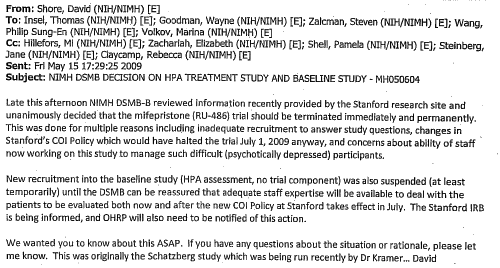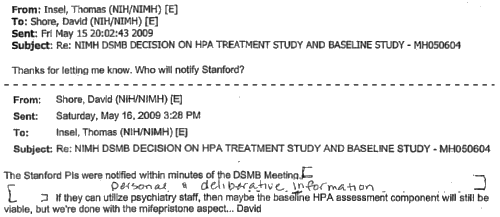While there are more things to say about Corcept and Mifepristone, I’ll save them for later and move to the center ring. In the years before 2008, there had been a growing outcry about the widespread Conflicts of Interest involving Academic Medicine’s ties to the Pharmaceutical Industry – blogs, newspaper articles, exposé literature, letters to journals, etc. But in 2008, there were a couple of new kids on the block, Senator Chuck Grassley [R-Iowa], Chairman of the Senate Finance Committee, and his investigative assistant, Paul Thacker [a remarkably effective investigator – see Money in biomedicine: The senator’s sleuth]. They carried a big stick – the US Congress and the federal funding of medical research through the National Institute of Health [NIH]. While Federal Grants are administered by academicians, the Grants actually go to the sponsoring Universities. When Senator Grassley cast his net, it pulled in two of the principals of Corcept that we’ve heard a lot about thus far – Drs. Charles Nemeroff and Alan Schatzberg – Departmental Chairmen who were at the top of the psychiatric hierarchy. Among other things, they were co-editors of the must-own tome Psychopharmacology. Dr. Schatzberg was the President of the American Psychiatric Association.
Dr. Nemeroff was the more vulnerable of the two. He had gotten in trouble with Emory for an article recommending treatments he had a stake in without disclosure [including Corcept‘s Mifepristone] in 2004 [Undisclosed Financial Ties Prompt Reproval of Doctor]. When he was removed as editor of Neuropsychopharmacology for a similar nondisclosure in 2006, Emory had imposed more sanctions [Journal Editor Quits Over Conflict of Interest]. So in 2008 when Senator Grassley and Paul Thacker documented Dr. Nemeroff’s continued large unreported income from Pharmaceutical Companies, including those whose drugs he was studying with NIMH Grants as Principal Investigator [Top Psychiatrist Failed to Report Drug Income], Emory removed him as Department Chairman and PI, and also banned him from applying for further NIMH funding for two years. The NIMH suspended the Grant pending review and imposed special scrutiny on any NIH Grant applications from Emory. Nemeroff left Emory to become Chairman in Miami in early 2010.
Dr. Schatzberg was not such an identified chronic offender as Dr. Nemeroff, and fared better. In June 2008, Grassley probed his involvement with Corcept while being the Principal Investigator on an NIMH Grant studying Mifepristone [Senate Targets Stanford Psychiatrist Over Conflicts]. Stanford defended him [and themselves], but Grassley kept coming [Grassley Intensifies Probe Into NIH & Stanford]. Shatzberg was removed as Principal Investigator from the NIMH Grant by Stanford in August, 2008 [Under Pressure, Stanford Pulls Schatzberg Grant]. In September 2010, Dr. Schatzberg retired as Chairman of Stanford’s Psychiatry Department. He had stepped down from the Corcept Board of Directors in late 2007, but remained on as Director of the Scientific Advisory Board.
| We shall not cease from exploration And the end of all our exploring Will be to arrive where we started And know the place for the first time. |
| Little Gidding, T.S.Eliot |
My favorite quote is here to return us to where this series began [Mifepristone 0: $tanford’s $chatzberg redux…]. Last week, Paul Thacker [now with the Project on Government Oversight] wrote a blog post about some recently unearthed [previously unreported] internal NIMH emails [The Ugly Underbelly of Medical Research]. They referred to a meeting of the NIMH DSMB [Data Safety Monitoring Board] held in May 2009 to discuss Stanford’s restructuring of the Grant [which included the trials of Mifepristone] after Schatzberg was removed.

| "… unanimously decided that the mifepristone [RU-486] trial should be terminated immediately and permanently." |

| "… but we’re done with the mifepristone aspect." |
The Chairman of Psychiatry at Stanford who was the Principal Investigator on an NIMH Grant to study the Hypothalmic-Pituitary-Adrenal Axis in Psychotic Depression founded a company to bring Mifepristone to market for clinical use – a drug that was being studied as part of that NIMH Grant. This impossible Conflict of Interest continued for a decade. Stanford University held the patent to the drug, and continuously defended Schatzberg’s position as proper [because it was disclosed], in spite of the fact that you couldn’t make up a more compromised situation if you tried. In reviewing the literature, the studies done at Stanford and by Schatzberg’s private company were indistinguishable.
The decision by the Data Safety Monitoring Board to permanently terminate the NIMH participation in this sham finally closes a parenthesis that should’ve never been allowed to open in the first place. It says to Stanford University, "Who do you think you’re kidding? We’re done!" It affirms the determination of Drs. Carroll and Rubin who have repetitively pointed out the Conflicts of Interest and the "massaged" Mifepristone studies hyped by Corcept Sockholders posing as academicians [often with no disclosure]. It validates the writings of industry watchers and journalists who have brought focus to the Corcept/Stanford unholy marriage. And it’s a testimonial to Senator Chuck Grassley and investigator Paul Thacker who finally found the Achilles heel that allowed it to happen. Hopefully, it will become a precedent for the future – at least a start. Here’s the banner:

Well, well! So they had a trial under way in schizoaffective disorder, did they? How’s that for chutzpah? This looks like they tried to use NIMH funds to set up their proprietary drug for indication creep. I can see it now. Another small Stanford trial with unconvincing results to be touted through academic review articles and textbooks authored by Corcept shareholders. Nice try, guys!
What’s wrong with this picture? Lots, but to me a gaping hole is the absence of data comparing the Stanford drug to standard treatments of psychotic depression. Zero. Zip. Nada. They have had 15 years to check that out, with millions of NIMH taxpayer dollars and over $150 million of venture capital. So, where’s the beef?